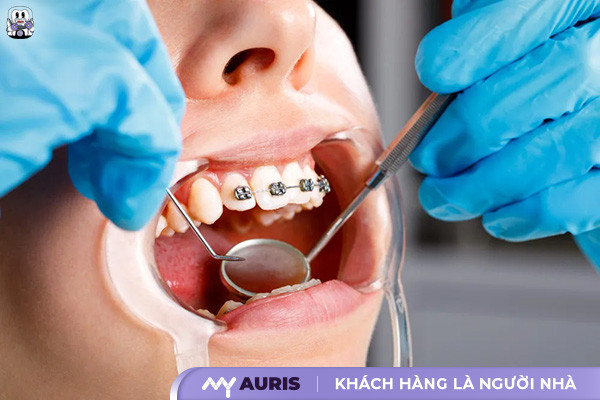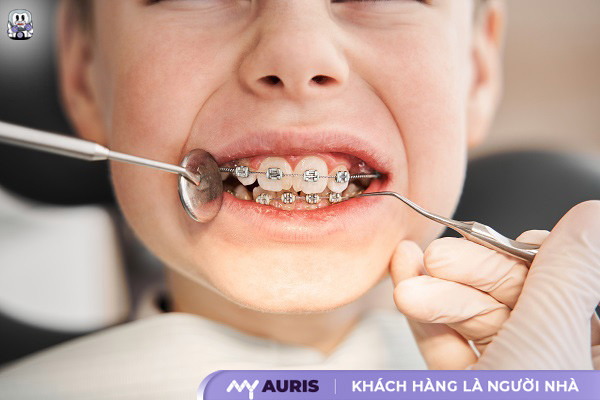The cost of braces for 10-year-olds ranges from 12 to 35 million VND, depending on the type of appliance and the degree of tooth misalignment. This is a common cost at reputable pediatric dental clinics. Early intervention helps save costs and improve treatment effectiveness for children at the age of jawbone development.
What is the cost of braces for 10-year-olds?
The current cost of braces for 10-year-olds ranges from 12 – 35 million VND, depending on the type of appliance and the degree of tooth misalignment. This is the average price recorded at reputable pediatric dental clinics in Ho Chi Minh City, Hanoi, and other major provinces and cities.
| Type of Braces Appliance | Reference Cost |
| Traditional Metal Braces | From 12 – 18 million VND |
| Ceramic Braces (Aesthetic) | From 18 – 25 million VND |
| Crystal or Clear Braces | From 25 – 35 million VND |
| Removable Appliances for Early Jaw Correction | From 6 – 12 million VND |
The cost of braces for 10-year-olds is not fixed, but if parents proactively take their children for early check-ups at reputable pediatric dental centers, it will not only help save costs but also enhance treatment effectiveness.

Should 10-year-olds get braces?
According to orthodontists at My Auris Dental, the age of 7–12 is the “golden age for braces.” This is a period of rapid jawbone development, which helps effectively intervene in cases of reverse bite in children or treat misaligned teeth without the need for extractions or surgical intervention later on.
When braces are applied early, the treatment time is shorter, costs are generally lower than for adults, and children adapt more easily to pediatric braces or removable appliances. Especially with phase 1 orthodontic treatment, the dentist can guide proper jaw development, preventing complex misalignments during puberty.
Common Types of Braces Appliances for Children Today
Below are the common types of appliances currently used in pediatric orthodontics, applied at reputable dental centers.
Traditional Metal Braces
This is the most common choice in pediatric orthodontics. Brackets are made of stainless steel and are directly bonded to the outer surface of the teeth. The fixed archwire creates traction to move the teeth into the correct position.
- Pros: Lower cost compared to other types of braces, highly effective for various types of tooth misalignment.
- Cons: Easily noticeable when smiling or speaking, which can cause children to lose confidence in communication.
Metal braces are suitable for children aged 7 to 12 with unevenly erupted teeth or misaligned bites.
Aesthetic Ceramic Braces
This is an improved version of metal braces but with a color similar to natural teeth. It is suitable for children who prioritize aesthetics or are self-conscious about being noticed.
- Pros: Less noticeable when worn, does not affect aesthetics.
- Cons: Higher cost, less durable than metal.
Ceramic braces are often used when parents have the means and the child cooperates well during treatment.
Crystal Braces
These appliances have high aesthetic appeal, made from clear crystal material. This is an intermediate option between metal and ceramic.
- Pros: Nearly invisible, suitable for children sensitive about their appearance.
- Cons: Fragile if the child eats hard foods, high cost.
The child’s age and level of cooperation should be considered before choosing this type of braces.
Removable Appliances (Phase 1 Braces)
Suitable for children in early developmental stages (6–10 years old), especially for cases of crossbite, deep bite, or jawbone misalignment.
- Pros: Can be removed for eating or cleaning, making it easy to adapt.
- Cons: Effectiveness depends on the child’s cooperation. Easily lost or damaged if not properly cared for.
Removable appliances are often the first step in early orthodontic treatment, aiming to guide jawbone development before moving on to the fixed braces phase.
Clear Aligners
Intended for older children or teenagers, rarely applied to 10-year-olds unless their permanent teeth have almost completely erupted.
- Pros: Nearly invisible, painless, easy to remove and insert, convenient for eating.
- Cons: Very high cost, not suitable for all cases of tooth misalignment.
Parents should consult with a specialized orthodontist to assess suitability.

Dental Braces Procedure for 10-Year-Olds
Clinical Examination and 3D Dental-Maxillofacial X-ray
A pediatric orthodontist will conduct a comprehensive oral examination, identify the current type of teeth (primary or permanent), the degree of tooth misalignment, and the bite. X-rays and 3D Cone Beam CT scans will help assess jawbone structure, the position of misaligned teeth, the temporomandibular joint, and the child’s jaw development.
Personalized Treatment Plan Creation
Based on X-ray results and the physical examination, the doctor will design an appropriate orthodontic treatment plan for the 10-year-old. If there are still many primary teeth, removable jaw correction appliances may be used. If the child has almost all permanent teeth, metal, ceramic, or crystal braces may be prescribed. The treatment plan will also specify the estimated duration and cost of braces.
Taking Impressions and Manufacturing Orthodontic Appliances
The doctor will take dental impressions to fabricate braces or specialized orthodontic appliances for the child. Some modern dental clinics use 3D scanners to reduce the time. The appliance can be either fixed or removable, depending on the treatment plan.
Appliance Placement and Usage Instructions
Once the appliance is ready, the child will be scheduled for an appointment at the dental clinic to have the braces placed. This process is gentle and painless. The doctor will instruct the child and parents on how to maintain oral hygiene and eat properly to avoid damaging the appliance.
Regular Check-ups and Archwire Adjustment
Every 3–6 weeks, the child needs to revisit the dentist for adjustments to the pulling force, archwire changes, or effectiveness checks. Adhering to the appointment schedule helps to control the treatment progress well and prevent complications.
Braces Removal and Retainer Wear
Once the teeth are aligned and the bite is stable, the doctor will remove the braces. The child will need to wear a retainer for several months to 1 year to maintain stable results. This is a crucial step that cannot be skipped.

Do Braces for 10-Year-Olds Hurt?
Braces for 10-year-olds are not overly painful if intervention is done at the right time and with the correct method. With the development of pediatric orthodontic techniques, children will adapt well if thoroughly explained, properly cared for, and encouraged by their families. Choose a reputable dental center with sufficient expertise and experience to accompany your child’s journey to a perfect smile.
Unlike adults, children aged 7 to 12 are in a period of strong jawbone development. Therefore, orthodontic intervention for children helps move teeth faster, while also limiting pain if there is a proper treatment plan from a specialized orthodontist.
Before deciding on braces, it is essential to seek advice from a doctor experienced in pediatric orthodontics. Parents should choose reputable clinics like My Auris Dental – which has a team of experts and modern equipment. This factor helps ensure treatment effectiveness and safety for children. Contact 0377.99.6879 for a free consultation today.





